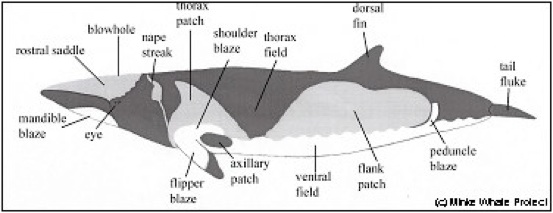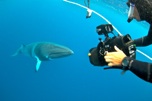INFORMATION ABOUT DWARF MINKE WHALES

Whales are in the order Cetacea, which can be further divided into two groups; toothed whales (Odontocetes) and baleen whales (Mysticetes).
Toothed whales have a single blow hole and peg-like teeth, which they use to capture fish and cephalopods, before swallowing them whole.
Baleen whales, often referred to as the great whales, are filter feeders. They use a system of horny plates, called baleen, to sieve small fish and planktonic organisms out of the water. These whales have paired blowholes.
Dwarf minke whales
Minke whales were thought to be a single, variable species of whale throughout the world’s oceans. However, scientific evidence has revealed at least two distinct species, the Northern Hemisphere minke (Balaenoptera acutorostrata) and the Antarctic or Southern Hemisphere minke (Balaenoptera bonaerensis). The minkes that visit the Great Barrier Reef during winter were only discovered in the 1980’s and are believed to be an ‘undescribed subspecies of the Northern Hemisphere minke’, commonly referred to as the dwarf minke whale.
The dwarf minke (dmw) is amongst the smallest of the baleen whales, reaching a maximum length of around 8m. Just as each of us has distinct fingerprints, each dwarf minke has unique colour patterns which are also different on the right and the left side of the body. Such intricate features help researchers identify whales, record and understand minke behaviour and study their population structure.

Name:
Balaenoptera acutorostrata subspecies
SIZE & Weight:
Dwarf minke whales (dmw) are born at 2m and can grow up to 8m in length. Adults can weigh around 6,000kg (6 tonnes). Size differences between male and female are yet to be determined.
habitat/Distribution:
Migratory species, habitat ranging from open ocean to the continental shelf
conservation status
Dmw have not yet been evaluated by the IUCN. Their relatives, the Southern Hemisphere minkes have been classified as Data Deficient (DD) and the Northern Hemisphere minke as Least Concern (LC)
biology
Age: Unknown but other species of minke live 50-60 years.
Breath holding: Up to 12.5 mins
Diving: Most baleen whales are relatively shallow divers, remaining in the upper 100–200 m of water. Dmw have been seen swimming at 20–40 m depth.
Speed: Have been recorded cruising at 8 knots with burst speeds of up to 20 knots
Diet: Small fish and krill
Sounds: Vocalizations are within the 50–9400 Hz range and thought to be generated in the larynx. Unlike the alluring sonnets produced by some species of whales, dmws produce a series of grunts, belches and moans which are audible to humans. A very distinctive, and more controversial, sound involves 3 short pulses, followed by a slight upsweep (this mechanical noise has been dubbed the 'Star Wars' sound).
Press play to hear the minke’s remarkable ‘star wars’ vocalisation


FILTER FEEDERS:
Baleen whales use hair-like plates that hang from the roof of their mouths to sieve out tiny prey from the ocean. This baleen is shown above on a dwarf minke and with researcher and Minke Whale Project founder, Dr Peter Arnold.
whales
Dwarf minke whale, Ribbon Reefs
Each dwarf minke whales has a unique colour patterns (much like a fingerprint in humans) that allow individuals to be identified.

The combination of colour patterns exhibited by dwarf minke whales is unique and distinguishes them from their larger cousins. Features include:
1. a dark band of colour on the neck, between the end of the mouth and the flipper, which continues as a dark throat patch extending on each side well down onto the throat. These dark throat patches are seen very clearly if the whale turns to expose the underside of the body.
2. the flipper colour, which is dark at the tip but completely white at the base of the flipper
3. the colour of the shoulder region, which is completely white where the flipper joins the body and extends as a white shoulder patch around much of the flipper
4. a light grey, roughly triangular thorax patch, which extends up each side of the animal from just above the white shoulder patch and flipper
It can be almost impossible to determine the gender of a whale unless there is a clear view of its underside. The difference lies in the shape and position of the genital slit, which in a female is in front and almost continuous with the anus (mammary slits are also visible on either side of the genital slit) and in a male is in front of and distinctly separated from the anus. In both sexes, the umbilicus ('belly button') is a distinct groove visible around the midline.
Human pressures such as boat strikes, net entanglement and global warming are indiscriminate killers of many sea animals, including whales. And with sea temperatures and ocean acidity on the rise this problem looks set to intensify. The Great Barrier Reef is considered one of the best-managed marine reserves in the world and there are a number of laws and guidelines in place to mitigate risks to its wildlife. Here, direct human-whale interactions are limited to a small and sustainably controlled swim-with-whale industry, but beyond these waters dmws may be in grave danger.
Dmw distribution and migration patterns are thought to overlap with their Southern hemisphere cousins, which make up a large portion of the ‘scientific whaling’ quota. Although dmws are not technically ’targeted’ they have been killed for scientific whaling purposes in the past - a program that many anti-whaling organizations claim is a front for commercial whaling.
Eye to Eye Marine Encounters, a leading swim with whale operator, openly encourages guests from whaling nations to participate in their swim with whale program so that they can experience for themselves a connection with one of the friendliest whales on the planet. They hope that these new experiences will create more ‘whale ambassadors’ to become another rational voice in the whaling debate.
conservation & whaling
Photo: Bryant Austin

For more on Dwarf Minke Whales including how to report a sighting, the Code of Practice and latest research findings click here.
2012 Minke Whale Project newsletter available here.
WHAT TO DO IF YOU SEE A WHALE?
